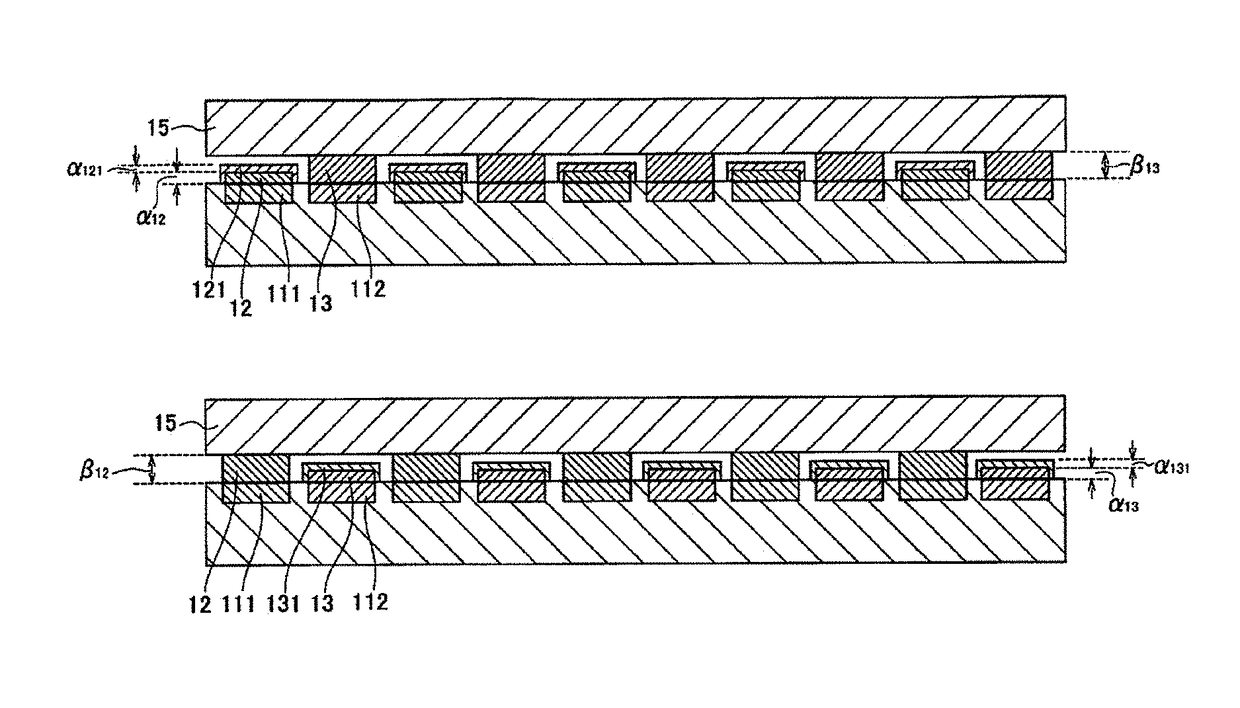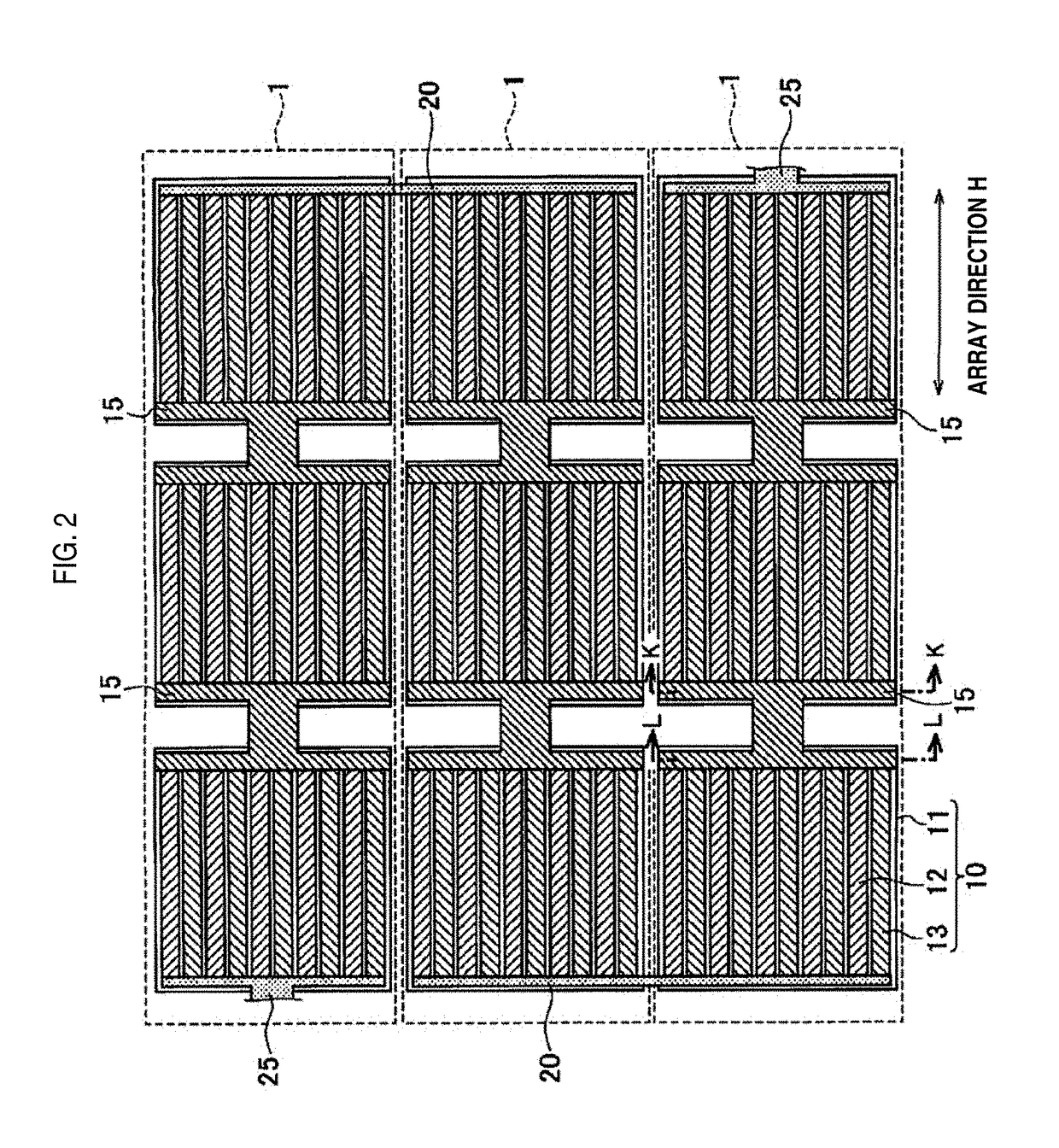Solar cell module
a solar cell and module technology, applied in the field of solar cell modules, can solve the problems of low collection efficiency of photogenerated carriers (electron or positive holes), and achieve the effect of preventing degradation of photogenerated carrier collection efficiency
- Summary
- Abstract
- Description
- Claims
- Application Information
AI Technical Summary
Benefits of technology
Problems solved by technology
Method used
Image
Examples
second embodiment
[0056]Next, with reference to the drawings, a second embodiment is described. A solar cell module in this embodiment has a similar configuration as above-described solar cell module 100 in the first embodiment. (referred to FIG. 1 and FIG. 2) In the following description, differences between the second embodiment and above-described first embodiment are chiefly described.
(Configuration of a Solar Cell)
[0057]FIG. 8A is a cross-sectional view taken along sectional line L-L of FIG. 2. FIG. 8B is a cross-sectional view taken along sectional line K-K of FIG. 2.
[0058]As shown in FIG. 8A, illustrating one solar cell 10, α12 indicates the thickness of the part of each n-type side electrode 12, which is facing wiring member 15. β13 indicates the thickness of the part of each p-type side electrode 13, which is facing wiring member 15. Thickness α12 is thinner than the thickness β13. Furthermore, thickness β13 is greater than total thickness of α121 and thickness α12 of n-type side cover 121. ...
working example 1
[0079]Firstly, n-type single-crystalline silicon substrate is prepared. It is formed approximately 100 mm square and thickness 200 μm and its resistivity is 0.1 Ωcm.
[0080]Next, by using screen printing method, n-type diffusing agent paste (containing phosphorus) and p-type diffusing agent paste (containing boron) are printed in lines, each agent forming 41 lines on the back surface of n-type single-crystalline silicon substrate, respectively. Further, by applying thermal diffusion treatment, 41 lines of each of n-type region and p-type region having 0.8 mm in width and 98 mm in length are formed at intervals of 2.4 mm.
[0081]Next, transparent conducting layer (ITO layer) is formed on respective n-doped region and p-doped region by sputtering method. After silver paste is printed on ITO layer by using screen printing method, n-type side electrode and p-type side electrode are formed. The dimension of each electrode is 0.8 mm in width, 98 mm in length and 30 μm in thickness. Then n-typ...
working example 2
[0086]In working example 2, thickness of silver paste, which is formed on n-type side cover above n-type side electrode, is formed 10 μm thinner than other surface area. Due to the fact that the thickness of n-type side cover is 10 μm; the surface of n-type side electrode and the surface of n-type side cover are even in thickness.
[0087]Similarly, thickness of silver paste, which is formed on p-type side cover above p-type side electrode, is formed 10 μm thinner than other surface area. Due to the fact that the thickness of p-type side cover is 10 μm; the surface of p-type side electrode and the surface of p-type side cover are even in thickness.
[0088]All other processes in working example 2 are the as above-described working example 1.
PUM
 Login to View More
Login to View More Abstract
Description
Claims
Application Information
 Login to View More
Login to View More - R&D
- Intellectual Property
- Life Sciences
- Materials
- Tech Scout
- Unparalleled Data Quality
- Higher Quality Content
- 60% Fewer Hallucinations
Browse by: Latest US Patents, China's latest patents, Technical Efficacy Thesaurus, Application Domain, Technology Topic, Popular Technical Reports.
© 2025 PatSnap. All rights reserved.Legal|Privacy policy|Modern Slavery Act Transparency Statement|Sitemap|About US| Contact US: help@patsnap.com



